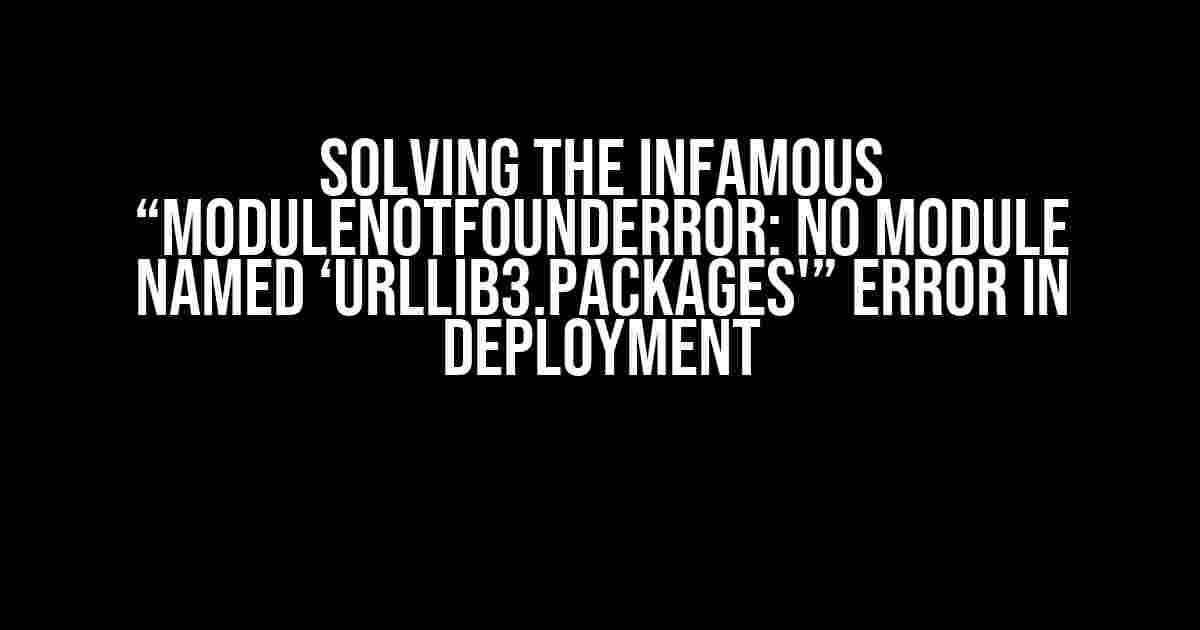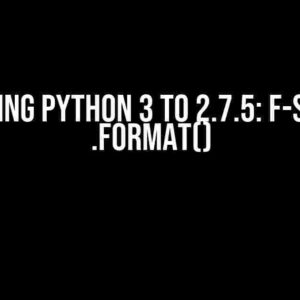If you’re reading this, chances are you’ve encountered one of the most frustrating errors in the world of deployment: “ModuleNotFoundError: No module named ‘urllib3.packages'”. Don’t worry, friend, you’re not alone! This error has stumped many a developer, but fear not, for we’re about to embark on a journey to vanquish this beast once and for all.
What is urllib3 and why do I need it?
Urllib3 is a powerful Python library that allows you to make HTTP requests and interact with web servers. It’s a dependency for many popular libraries, including Requests, which is used by countless frameworks and applications. In short, urllib3 is an essential tool for any web developer.
What causes the “ModuleNotFoundError: No module named ‘urllib3.packages'” error?
This error typically occurs when your deployment environment is missing the urllib3 library or one of its dependencies. This can happen for a few reasons:
- Missing or outdated urllib3 installation
- Incompatible Python version
- Corrupted package installations
- Version conflicts with other dependencies
Solving the Error: Step-by-Step Guide
Don’t worry, we’re about to dive into the trenches and tackle this error head-on. Follow these steps to get your deployment up and running in no time!
Step 1: Check Your Python Version
Make sure you’re running a compatible Python version. Urllib3 supports Python 2.7, 3.4, 3.5, 3.6, 3.7, and 3.8. If you’re running an older version, consider upgrading to a supported version.
python --version
Step 2: Install or Update Urllib3
Install or update urllib3 using pip:
pip install --upgrade urllib3
If you’re using a virtual environment, make sure to activate it before running the command.
Step 3: Verify Urllib3 Installation
Check if urllib3 is installed correctly by running:
python -c "import urllib3; print(urllib3.__version__)"
If you see the version number printed, it means urllib3 is installed correctly. If not, go back to Step 2 and try again.
Step 4: Check for Corrupted Packages
Sometimes, packages can become corrupted during installation. Try reinstalling urllib3 and its dependencies:
pip uninstall urllib3
pip install --upgrade urllib3
Step 5: Verify Dependencies
Check if other dependencies are causing issues. Try installing the following packages:
pip install --upgrade requests
pip install --upgrade six
pip install --upgrade pyOpenSSL
Step 6: Debug Your Deployment Script
If you’re still encountering issues, review your deployment script for any errors or inconsistencies. Check for:
- Incorrect Python versions or environments
- Missing or incorrect package installations
- Typos or syntax errors
Troubleshooting Tips and Variations
If the above steps don’t solve the issue, try these additional troubleshooting tips:
Variation 1: Using a Virtual Environment
If you’re using a virtual environment, make sure to activate it before running your deployment script. You can also try creating a new virtual environment and installing urllib3 from scratch.
python -m venv myenv
source myenv/bin/activate
pip install --upgrade urllib3
Variation 2: Using Docker
If you’re using Docker, ensure that your Dockerfile includes the correct Python version and urllib3 installation:
FROM python:3.7-slim
RUN pip install --upgrade urllib3
Variation 3: Using a Requirements File
If you’re using a requirements file, make sure to include urllib3 in your dependencies:
urllib3==1.25.10
Then, install the dependencies using:
pip install -r requirements.txt
Conclusion
Congratulations! You’ve made it to the end of our epic battle against the “ModuleNotFoundError: No module named ‘urllib3.packages'” error. With these steps and troubleshooting tips, you should be able to resolve the issue and get your deployment up and running smoothly.
Remember to stay calm, patient, and persistence when debugging errors. Happy coding, and may the debugging forces be with you!
| Common Errors | Solutions |
|---|---|
| ModuleNotFoundError: No module named ‘urllib3.packages’ | Check Python version, install or update urllib3, verify installation, and troubleshoot dependencies |
| Urllib3 installation issues | Reinstall urllib3, check for corrupted packages, and verify dependencies |
| Deployment script errors | Debug script for typos, syntax errors, and incorrect package installations |
We hope this comprehensive guide has helped you conquer the “ModuleNotFoundError: No module named ‘urllib3.packages'” error. If you have any further questions or concerns, feel free to ask in the comments below!
Related Articles
- Solving the “ImportError: No module named ‘requests'” Error
- Debugging Python Import Errors: A Step-by-Step Guide
- Top 10 Python Libraries for Web Development
We’d love to hear about your experiences and tips for solving this error in the comments below! Share your knowledge and help others overcome this frustrating issue.
Frequently Asked Questions
Got stuck with the “ModuleNotFoundError: No module named ‘urllib3.packages'” error while deploying? Don’t worry, we’ve got you covered! Here are some frequently asked questions and answers to help you troubleshoot the issue.
What is the “ModuleNotFoundError: No module named ‘urllib3.packages'” error?
This error occurs when the Python interpreter is unable to find the ‘urllib3.packages’ module, which is a dependency for some libraries. It’s like trying to find a key that’s not in your pocket!
Why does the error happen during deployment?
During deployment, the error can occur if the ‘urllib3.packages’ module is not installed or not properly declared as a dependency in your project’s requirements file. It’s like packing for a trip but forgetting your passport!
How to resolve the “ModuleNotFoundError: No module named ‘urllib3.packages'” error?
You can resolve the error by installing the ‘urllib3’ library using pip: `pip install urllib3`. Alternatively, you can declare ‘urllib3’ as a dependency in your project’s requirements file. Voilà! The error should be gone!
What if I’m using a virtual environment?
If you’re using a virtual environment, make sure to activate it before installing the ‘urllib3’ library. You can activate the virtual environment using `source venv/bin/activate` (on Linux/macOS) or `venv\Scripts\activate` (on Windows). Then, install the library using pip.
How to avoid the error in the future?
To avoid the error in the future, make sure to keep your dependencies up-to-date by regularly running `pip freeze` and `pip install -r requirements.txt`. Additionally, declare all dependencies in your project’s requirements file to ensure a smooth deployment. Be prepared, not stuck!



